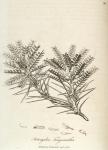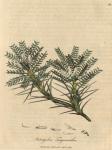
 Ex hac planta exudat Gummi Tragacantha. Pharm. Lond. & Edinb.
Ex hac planta exudat Gummi Tragacantha. Pharm. Lond. & Edinb.
Synonyma. Astragalus aculeatus fruticosus Massiliensis. Pluk. Alm. p. 60.
Tragacantha. Bauh. Pin. p. 388.
Tragacantha, sive spina hirci. Gerard Emac. p. 1328.
Tragacantha vera. Park. Theat. p. 995.
Tragacantha Massiliensis. J. Bauh. Hist. i. p. 407. Raii Hist. p. 933. Du Hamel, Traité des Arbres, t. ii. p. 343. Tournefort, Voyage du Levant, t. i. p. 21.
Class Diadelphia. Ord. Decandria. Lin. Gen. Plant. 892.
Ess. Gen. Ch. Legumen biloculare, gibbum.
Spec. Char. A. caudice arborescente, petiolis spinescentibus.
The root is perennial, long, tapering, and fibrous: the stems are shrubby, short, thick, branched, procumbent, clothed with brown rigid fibres, and beset with long sharp spines: the leaves are pinnated, consisting of about eight pairs of small oblong pinnulae, or leafits, which are attached to a strong spinous persistent footstalk, or midrib: the flowers are large, of a pale yellow colour, and terminate the branches in close clusters: the calyx is tubular and divided at the rim into five sharp teeth: the corolla is of the papilionaceous kind, consisting of a vexillum or upper petal, which is longer than the others, straight, blunt, reflected at the sides, and notched at the end; two alae or lateral petals, which are of an oblong form, and a carina or keel-shaped under-petal: the filaments are ten, nine of which are united, and one separate: the antherae are small and round: the germen is long and roundish: the style tapering, and furnished with a blunt stigma: the seeds are kidney-shaped, and contained in a two-celled pod. It flowers from May till July.
This plant was cultivated in England in the time of Parkinson, (1640): it is a native of Asiatic Turkey, and the Southern parts of Europe, particularly of Italy, Sicily, and Crete. Tournefort discovered it growing plentifully about Mount Ida, [Voyage, T. i. p. 21.] where he examined the plant in the month of July, when both the bark and wood were found distended with gum Tragacanth, which by the intensity of the sun's heat forces its way through the bark, and concretes into irregular lumps, or long vermicular pieces, bent into a variety of shapes, and larger or smaller in proportion to its quantity, and the size of the wounds from whence it issues. This gum is imported here chiefly from Turkey: it varies in its colour; but that most esteemed is white, semitransparent, dry, yet somewhat soft to the touch.
M. de la Billardière's late account [See Description d'une nouvelie espece d'astragale, qui produit au Liban la gomme adragant, Hist. de l'Acad. R. des Scien. du 16 Dec. 1788. et Rosier, Observ. sur la physique, pour Janvier, 1790.] of the production of this gum differs in some respects from that of Tournefort's. He says, that he visited Mount Lebanon in August, 1786, the season when the gum Tragacanth is collected: he then found the species of Astragalus which afforded it, to be different from that figured and described by Tournefort, and consequently not the Tragacantha of Linnaeus. [He makes the following distinctions: The stem of the Cretan Astragalus is blackish, that of Libanon is yellow; the leaves of the first are downy, of the second they are smooth. The flowers of one are red, those of the other are of a pale yellow. From hence he infers that there are various species of Astragalus which produce gum tragacanth.] He also contradicts the opinion of Tournefort, who attributes the flowing of the gum to the contraction of the fibres of the bark, occasioned by the intensity of the solar heat; observing that it is only during the night, or when the sun is obscured by clouds, that the gum issues from the plant, and that the same has been remarked at Crete.
"Gum Tragacanth differs from all other known gums, in giving a thick consistence to a much larger quantity of water; [Multo fortius est hoc gummi, quam G. arabicum, sc. ut 1 ad 24. Etenim dum G. Tragac. scrup. 8 aquae purae libr. 2 in consistentiam Syrupi redigunt, requiruntur G. Arab. unc. 8 ad eundem effectum praestandum. Berg. M. M. p. 622.] and in being much more difficultly dissoluble, or rather dissolving only imperfectly. [Rutty asserts, that in five or six hours it will dissolve in cold water. Observ. on the Lond. & Edin. Dispen. p. 179.] Put into water, it slowly imbibes a great quantity of the liquid, swells into a large volume, and forms a soft but not fluid mucilage: if more water be added, a fluid solution may be obtained by agitation, but the liquor looks turbid and wheyish; and on standing the mucilage subsides, the limpid water on the surface retaining little of the gum:" [Lewis's M. M.] nor does the mixture of gum arabic promote their union.
The demulcent qualities of this gum are to be considered as similar to those of gum arabic: [See p. 189. Bergius says, Virtus: demulcens, obtundens, incrassans. Usus: Dysenteria. Diarrhoea, Stranguria. l. c. p. 621.] it is seldom given alone, but frequently in combination with more powerful medicines, especially in the form of troches, for which it is peculiarly well adapted. It gives name to an officinal powder, and is an ingredient in the compound powder of ceruss.

